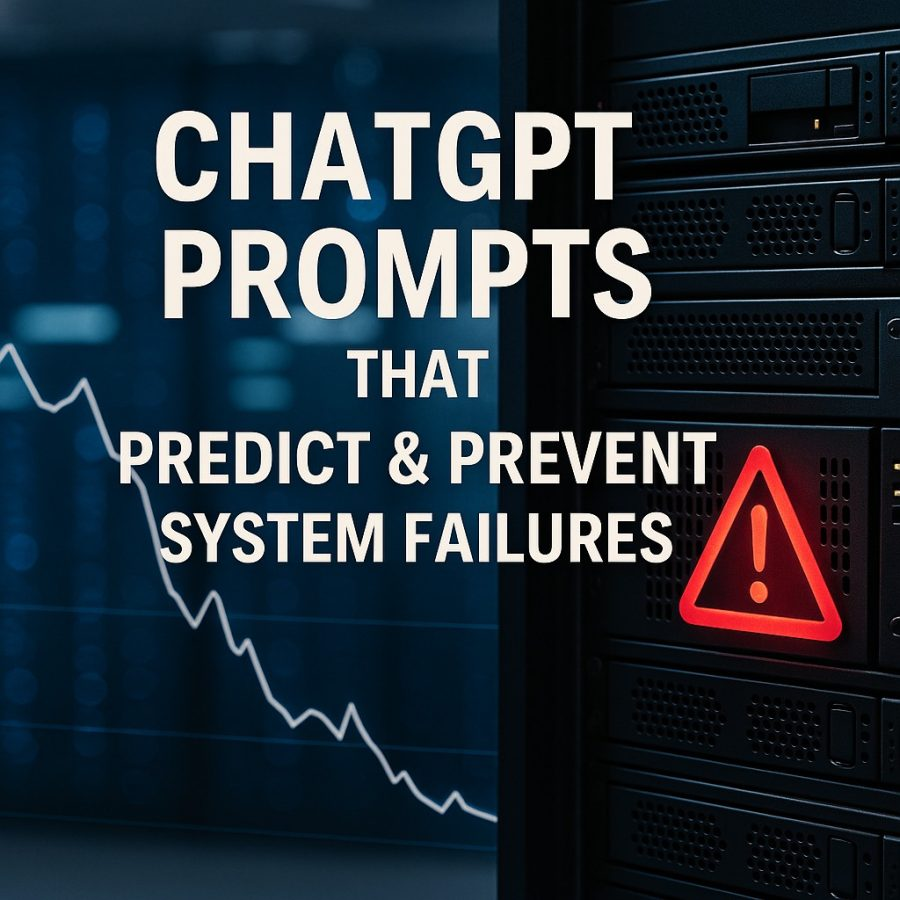Views: 3
Modern systems are complex. They include hardware, software, networks, databases, sensors, and human operators. A single unexpected event can cascade into full-blown failure. Monitoring and reactive alerts are useful. But prediction and prevention are better. If you can foresee trouble and avert it you save downtime, cost, frustration, and reputation. That is why ChatGPT Prompts That Predict and Prevent System Failures are valuable tools in your reliability toolkit.
In this article you will learn how to craft prompts that help detect anomalies early, forecast system crashes, and propose preventive measures. You will get best practices, sample prompts, use-cases, limitations, and integration ideas. The goal is to enable you to build reliability workflows where failures become rare rather than inevitable.
Why Predicting Failures Matters
Cost of Unplanned Downtime
Every minute a system is down costs money. Lost productivity, broken SLAs, angry users, potential loss of data. In many industries cost escalates rapidly. Predicting system failures helps avoid the surprise.
Improving User Trust and Safety
Systems that fail randomly lose trust. Data corruption, unexpected behavior, security lapses—these harm your credibility. Prevention increases safety and reliability. Reliability becomes part of reputation.
Efficiency of Maintenance
Reactive maintenance is more expensive. Preventive or predictive maintenance lets teams fix issues before they grow. Predictive maintenance uses sensor data, logs, usage patterns to schedule repair or patching before failure. (Wikipedia: Predictive maintenance?utm_source=chatgpt.com) (Wikipedia)
Key Principles Behind Predicting and Preventing Failures
Before using prompts you should understand what makes prediction feasible and prevention effective.
- Fault tolerance and redundancy. Systems built to absorb failure of a component without collapse remain live. Redundancy in hardware, fallback services, backup data paths help. (SentinelOne)
- Monitoring and anomaly detection. Continuous observation of logs, metrics, performance counters. Detect anomalies or change-points early. Techniques include statistical thresholds, machine learning or time series change-point detection. (arXiv)
- Regular maintenance and testing. Scheduled checks, patching, cleaning, load testing, capacity planning. Preventive steps reduce build-up of hidden risks. (Lenovo)
- Incident post-mortem and root cause analysis. When failures occur learn immediately what caused them and adjust accordingly to prevent recurrence. (DevOps.com)
What Makes a Good Prompt for Prediction and Prevention
To get value from AI you must craft prompts with certain features.
- Clarity about input data. You must be explicit about what logs, metrics, timestamps, sensor info, environmental factors you have.
- Define failure modes to predict. For example crash, memory leak, CPU spike, network partition, service outage.
- Specify threshold or risk indicators. What constitutes “too high” error rate, unusual latency, excessive CPU usage, disk I/O build-ups.
- Ask for preventive steps. Not just prediction. You want remedies, mitigations, fallback strategies.
- Context of system environment. Hardware specs, software versions, dependencies, external conditions.
Sample Prompts That Predict and Prevent System Failures
Below are sample prompt templates. You can adjust them for your domain whether software services, IoT, industrial machinery, cloud infrastructure.
Prompt 1: Log-Based Crash Forecast
You are my System Safety Analyst. I will provide you with historical system logs for services, error rates, latency metrics, CPU and memory usage. Identify patterns that suggest upcoming crash risk in the next 24 hours. Provide list of potential root causes. Propose three preventive actions that my engineering team can perform now and in the next week to avoid the crash.
Prompt 2: Sensor Anomaly Detection
You are my Predictive Maintenance Assistant. Given time series data from sensors (temperature, vibration, pressure), detect anomalies or change-points that are leading indicators of system failure. Highlight which sensors show highest risk, estimate remaining useful life of the component, and suggest preventive maintenance tasks.
Prompt 3: Dependency Failure Prediction
You are my System Dependency Monitor. I will give you a map of service dependencies, recent failure incidents, and traffic patterns. Predict which service nodes are most likely to fail under current or expected load conditions. Recommend architectural changes, fallback paths or redundancy to prevent cascading failure.
Prompt 4: Performance Degradation Before Failure
You are my Performance Guard. I will supply recent metrics including disk I/O, network throughput, memory usage, error logs, and user-facing latency. Identify performance degradation trends. Forecast when the system may cross critical thresholds. Propose actions to shore up capacity or optimize code.
Prompt 5: Security-Driven Failure Prediction
You are my System Security Analyst. Based on known vulnerabilities, patch records, intrusion detection alerts, and configuration drift, anticipate security related failures (e.g. exploit, data breach). Recommend preventive controls, patching schedule, monitoring configuration to reduce risk.
Case Studies: Prompts in Action
Here are examples of how real or hypothetical systems use prompts like those above.
Industrial Equipment Example
A factory uses vibration and temperature sensors on motors. Team uses prompt similar to Prompt 2. The model detects rising vibration at a motor bearing beyond the usual envelope. Prompt flagged it before audible noise or visible damage. Preventive maintenance fixed bearing and avoided downtime.
Cloud Service Platform
Engineering ops team monitors multiple microservices. They use prompt like Prompt 3 combined with log-based crash forecast. When traffic surged unexpectedly, dependency analysis revealed a database was under high I/O load. Team spun up additional replicas and throttled upstream services. They prevented cascading failure, service remained available.
The following is a referral or affiliated link that AltPenguin receives compensation for, should the link be used and the offer is completed. To provide full transparency, we at AltPenguin are stating this before you click the image below (the image will open a new page to the offer shown in the image).
SaaS Application
An application is seeing slow but increasing memory usage in certain modules. Using performance degradation prompt the team identified a memory leak in a rarely tested feature. They patched and rolled back gradually. Users did not notice disruption.
Best Practices to Use These Prompts Effectively
To get real benefit from ChatGPT Prompts That Predict and Prevent System Failures follow these practices.
Practice A: Use Reliable, Clean Data
Bad input leads to bad predictions. Ensure data is correctly formatted, timestamps align, measurements are consistent. Remove noise or irrelevant log entries. Label known failures so model or prompt understands what failure looks like.
Practice B: Incorporate Redundancy and Fault Tolerant Patterns
Combine prompt-based insights with design patterns like circuit breaker, fallback services, graceful degradation. Fault tolerance ensures that even if one component fails prediction missed, system still stands. (Wikipedia)
Practice C: Continuous Monitoring and Feedback
Once you get predictions and act on them track whether interventions succeeded. Track metrics like mean-time-between failures (MTBF), mean-time-to-repair (MTTR). Use post-mortem analysis. Adjust thresholds or prompt logic over time. (DevOps.com)
Practice D: Test in Staging Before Deploying
Run predictive prompts in test or staging environment. See false positives or negatives. Adjust before acting on production warnings. Prevent panic, unnecessary changes.
Limitations and Risks to Be Aware Of
Even excellent prompt-based prediction has limits.
- False positives and false negatives. Predicting failure might raise too many alarms or miss some. Both cases cost resources or trust.
- Data drift. Past signals may not represent future failure modes. Systems evolve. Models and prompt assumptions must update.
- Overhead and cost. Monitoring, data collection, redundancy, backups cost money. Organizational investment required.
- Complexity of cause. Many failures are multi-factor. Root cause may be unclear even with logs and metrics. Prompt suggestions are helpful but may require domain expert review.
The following is a referral or affiliated link that AltPenguin receives compensation for, should the link be used and the offer is completed. To provide full transparency, we at AltPenguin are stating this before you click the image below (the image will open a new page to the offer shown in the image).
Integrating ChatGPT Prompts into Your System Maintenance Workflow
To make ChatGPT Prompts That Predict and Prevent System Failures part of your standard ops, you can embed them into workflows.
Step 1: Define Key Failure Scenarios
Make a list of your critical failure types. E.g. service crash, data corruption, security breach, hardware failure. Use those as templates for prompts.
Step 2: Schedule Prompt Runs
Automate or assign weekly runs of prompts. For example: every Friday evening run “Log-Based Crash Forecast” for the past week. Or after load spikes.
Step 3: Alerting and Incident Response Integration
When prediction identifies serious risk, generate alerts or work tickets. Integrate with tools like PagerDuty or Slack. Ensure there is a person or team responsible.
Step 4: Documentation and Post-Mortem Learning
Each prediction and intervention should be documented. Log what prompt was used, what you found, what actions taken, outcome. After any failure, whether predicted or not, perform root cause analysis and adjust prompts and thresholds.
Sample Universal Prompt to Predict and Prevent Failures
Here is a composite prompt you can adapt to many systems.
You are my System Failure Prevention Agent. I will supply recent logs, metrics, sensor data, configuration drift records, and dependency topology. First, analyze for patterns that predict system failures in next 24 to 72 hours. Second, identify which components, services, or sensors are high risk. Third, propose at least three preventive actions I can implement now. Fourth, suggest longer-term architectural or design changes to reduce recurring risk. Confirm data sufficiency before proceeding.
You can adjust time window, type of data, system-type (software, industrial, cloud, IoT), threat models as needed.
The following is a referral or affiliated link that AltPenguin receives compensation for, should the link be used and the offer is completed. To provide full transparency, we at AltPenguin are stating this before you click the image below (the image will open a new page to the offer shown in the image).
Real Research Insights that Support Prompt-Based Prediction
Recent studies validate building early warning systems:
- The Gaussian Derivative Change-Point Detection method for industrial systems can detect shifts in behavior that precede failures. It combines change-point detection and long-short term memory networks to estimate remaining useful life. (arXiv)
- CrashEventLLM explores using large language models to predict system crashes from historical logs and to provide reasoning about causes. (arXiv)
- Predictive maintenance in industrial settings reduces unplanned stops by monitoring sensor data and usage. (Wikipedia)
Example Prompt Deployment Workflow
Here is how you might deploy ChatGPT Prompts That Predict and Prevent System Failures inside your organization.
- Establish data pipelines: logs, sensor feeds, usage metrics.
- Choose initial prompt template (e.g. Prompt 1 or Prompt 2 above).
- Run prompt in a staging or analysis environment weekly.
- Review output with engineering, operations, security teams.
- Take preventive action: patch, add redundancy, clean up configuration errors.
- After a few cycles measure if number of incidents drops, or MTTR drops.
Conclusion
Predicting failure is not magic. It is practice. It is data. It is discipline. When you use ChatGPT Prompts That Predict and Prevent System Failures you shift from firefighting to foresight. You build systems that are resilient rather than fragile. You reduce cost, risk, and downtime. You improve trust and capability.
Begin with one prompt. Use good data. Apply preventive steps. Monitor results. Adapt. Over time failures become rarer, performance becomes more stable, and your systems serve rather than surprise.





